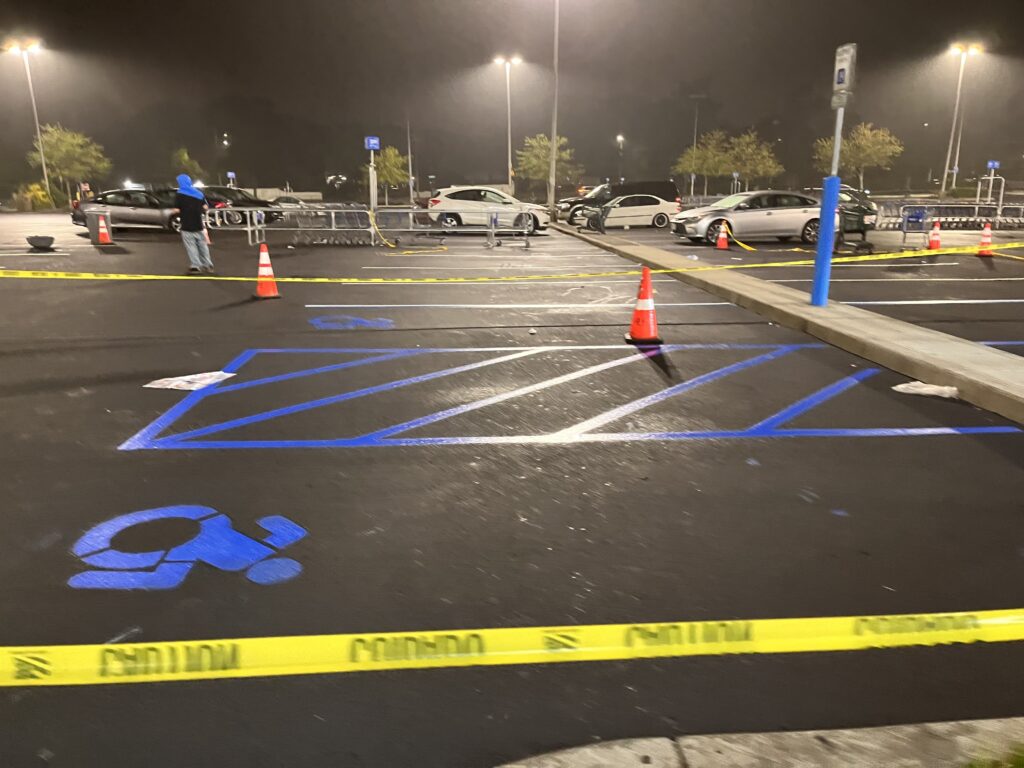
The Americans with Disabilities Act was signed into law in 1990 and amended in 2008. This comprehensive piece of legislation focuses on protecting the rights of those with disabilities against discriminatory housing or employment practices. However, most Americans are more familiar with the ADA’s provisions that cover accessible parking spaces, routes, and doors. ADA Compliance is the most important when running a commercial parking lot. The ADA also specifies the acceptable properties of a compliant ramp.
ADA-Compliant Ramps
Before continuing, it might be helpful to define some of the terms used in the section of the ADA Compliance that concerns ramps.
• Run: The run, sometimes referred to as the horizontal run, is the length of the ramp.
• Rise: The rise is the total vertical change. For example, four steps that are each six inches in height would represent a rise of 24 inches.
• Slope: Slope is similar to pitch, but slope typically expresses the inches of rise per every 12 inches of run. For example, if a ramp has a rise of 48 inches and a length of 144 inches, the slope would be 4:12. If you want to express the slope as a percentage, you would divide 48 by 144, then multiply by 100, which would give you an equivalent slope of 33.3%.
• Pitch: Pitch, which also refers to the slope ratio, expresses the ratio of the rise to the run. Typically, you express pitch as a fraction calculated by dividing the rise by the run. Using the numbers from the previous example, dividing 48 by 144 yields a pitch of 1/3.
What Are the ADA Requirements for the Slope of Egress Ramps?
The ADA Compliance includes ramps used for accessing a building must have a slope of 1:12, which means that every inch of rise must have 12 inches of run. To illustrate, if the rise is 24 inches, the ramp must be 24 feet in length. The maximum rise is 30 inches, so no ramp or section of a ramp can exceed 30 feet. If a longer ramp is required, it will be necessary to divide the ramp into runs of less than 30 feet, and there must be a landing between the runs to serve as a rest area or turning platform. There must also be level platforms at the top and bottom of the ramp. The ramp’s cross slope cannot exceed 1:48.
What About Other Types of Slopes Covered by the ADA?
Although most people think of ramps when they consider ADA-compliance based slopes, one commonly overlooked compliance issue involves parking lots. Accessible parking spaces and their adjacent access aisles cannot have a slope of more than 2% in any direction. This can be expressed as a slope of 1:50. Accessible routes cannot exceed 5% slope, and they cannot have a cross slope of more than 2%. Curb ramps are generally required to have a slope of no more than 1:12.
Let Royal Pavement Solutions Handle Your ADA Compliance
ADA compliance is complicated, but we have the experience and training to ensure that your parking lot is in full compliance. We offer concrete work, site work, asphalt paving, parking lot striping, asphalt repair, milling, and sealcoating. We have earned an exemplary reputation by consistently providing exceptional work and extraordinary customer service. You can request a free quote or discuss your paving needs by calling 844-777-7924, or you can use the online form to contact us.

